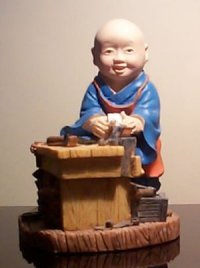| Contents
54. Sects in Chinese Buddhism
- Sects in Chinese Buddhism
54.1 Ten Great Sects
In summary, there were thirteen ‘tsung’s in Cinese Buddhism, namely,
- Chu-she tsung ( 俱舍宗
) / Kosa Sect in Sanskrit, originated from Abhidharama School
or Realistic School in India
- Cheng-shih tsung ( 成實宗
) / Satyasiddhi Sect in Sanskrit
- Lu tsung ( 律宗
) / Vinaya Sect in Sanskrit
- Chan tsung ( 禪宗
) / Dhayna Sect in Sanskrit / Zen in Japan, sometimes it is called
Meditation School, or simply The School
- Ching-tu tsung ( 淨土宗
) / Sukhavati Sect in Sanskrit / Pure Land Sect, sometimes it
is called Amidsim
- Hus-yen tsung ( 華嚴宗
) / Avatamsaka Sect in Sanskrit / Flower Adornment Sect
- Tien-tai tsung ( 天台宗
) / Heavenly Platform Sect
- Fa-hsien tsung ( 法相宗
) / Dharmalaksana Sect in Sanskrit / Mere-consciousness Sect /
Hosso in Japan, originated from Yogachara School in India
- San-lun tsung ( 三論宗
) / Three Shastra Sect / Sanron in Japan, originated from Madhyamika
School in India
- Chen-yen tsung ( 真言宗
) or Mi tsung ( 密宗
) / Esoteric School / Mantrayana or Tantrayana in Sanskrit / Word
of Truth Sect / Shingon in Japan
- Ti-lun tsung ( 地論宗
)
- Nirvana Sect ( 涅槃宗
)
- She-lun tsung ( 攝論宗
)
Later, Ti-lun tsung merged in Hua-yen tsung, Nirvana Sect merged
in Tien-tai tsung, and She-lun tsung merged in Fa-hsien tsung.
There were only eight sects in Mahayana sects. Together with Chu-she
tsung and Cheng-shih tsung as Hinayana, there are 10 sects in Chinese
Buddhism.

54.2 Categorization of Sects
These sects can be categorized into five main streams, namely,
- Vinaya
- Chan
- Amidism
- Esoterism
- Teaching, such as Hua-yen, Tien-tai, Fa-hsien, San-lun 華嚴,天台,三論,法相
It must be clear that Shakyamuni Buddha did not establish these
sects. These teachings evolved to accommodate varying characteristics
and temperaments of all people as time goes by.
In the western world, they like to categorize in other ways. They
regard Chu-she, San-lun and Fa-hsien as the ‘classical schools’,
as these schools were originated from later Indian Buddhism. Tien-tai
and Hua-yen are regarded as the ‘scholastic schools’, as they are
made in China. At last, Chan and Ching-tu are said to be the ‘popular
schools’, because they had a more direct appeal to the common people.
Certainly, it is not just one way to achieve enlightenment through
study and cultivation in Buddhism, thus the development of sects
is a natural trend. As all Dharmas converge to the supreme Buddhahood,
each way should have no hindrance to the other.
In recent years, people prefer to practice Ching-tu, i.e. Pure
Land. However, some people are eager to learn more about the theories
and practices of other sects. We will elaborate each sect later.
However, we would like to reiterate that it is better to focus to
one single sect in order to practice and cultivate effectively and
efficiently.
|